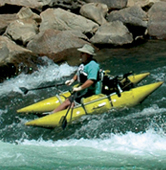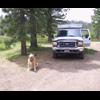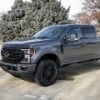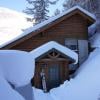
"Manual" Battery Isolator
#1

Posted 23 September 2009 - 02:45 PM
A little background: my wife and I just bought a used Phoenix popup and I've been been making some adjustments to make the camper work with our 2003 Tundra. I am going to use 10 gauge wire to hook up the truck battery to the camper battery for charging while driving. Rather than install an isolator, I'm simply going to install a pretty heavy duty plug on the camper so I can "unplug" from the truck charging system when we park, and switch the 3-way fridge to propane. I'll be the "isolator." Here's my noob question: what size inline fuse should I use?
Thanks in advance for being patient with a neophyte.
-DurangoSteve
#2

Posted 23 September 2009 - 05:06 PM
First of all, this is my first post and I want to thank the members for a lot a useful information I have gleaned from your threads.
A little background: my wife and I just bought a used Phoenix popup and I've been been making some adjustments to make the camper work with our 2003 Tundra. I am going to use 10 gauge wire to hook up the truck battery to the camper battery for charging while driving. Rather than install an isolator, I'm simply going to install a pretty heavy duty plug on the camper so I can "unplug" from the truck charging system when we park, and switch the 3-way fridge to propane. I'll be the "isolator." Here's my noob question: what size inline fuse should I use?
Thanks in advance for being patient with a neophyte.
-DurangoSteve
30 amp.
if you attempt to start the engine while plugged in i expect you will pop the fuse. be careful.
let us know how that works for you.
#3

Posted 23 September 2009 - 08:31 PM
2022 F350 7.3L; family trailer at the moment and some aluminum stuck together to eventually form another truck camper
#4

Posted 23 September 2009 - 10:42 PM
30 amp.
if you attempt to start the engine while plugged in i expect you will pop the fuse. be careful.
let us know how that works for you.
I agree completely with Jeff about starting the engine while plugged in. If you go this route, you might want to put a red "remove before flight" ribbon on the plug and ensure it's in a highly visible location that you will see before turning the key.
#5

Posted 23 September 2009 - 11:41 PM
#6

Posted 24 September 2009 - 12:41 AM
My advice is that if you have paid good money for a truck camper, spend a little bit more for an isolater. The first time you run down your starting battery(ies) while camping, you will wish the disconnect from your camper battery(ies) had been automatic.
#7

Posted 24 September 2009 - 01:47 PM
#8

Posted 24 September 2009 - 02:40 PM
Mount the battery under the hood and run a two conductor 10 or 12 gauge romex back to the camper plug in. Do not use the 7 pin connector at the rear of the truck. You need to have the battery as close as possible to your alternator because the voltage loss on a long wire is significant. If you are attempting to charge the battery in parallel with the other under hood battery hanging out there on a long wire, it will never be more than half charged.
By mounting your second battery under hood, you can disconnect it as you please and it will function pretty well in parallel. However, you really need a way to charge each battery individually. The style of usage will be different between batteries where one is used as the "house" battery and the other is used as the "Starting" battery. Thus, it is really essential to have a way to switch batteries. What folks are telling you is entirely correct about having some kind of isolator, preferable a three position switch made for the purpose, either mechanical or electronic, as the case may be.
Again, the least expensive solution is a dual alternator set up. Each battery has its own alternator. This is by far the best solution and another way to isolate the two batteries. If you have a dual alternator set up, you can then place the battery in the camper without any worries about popping fuses, losses over a long wire, and other things. Dual alternators is the elegant, and probably the least expensive solution in the long run.
John D
#9

Posted 24 September 2009 - 02:50 PM
DurangoSteve, Great handle.
Mount the battery under the hood and run a two conductor 10 or 12 gauge romex back to the camper plug in. Do not use the 7 pin connector at the rear of the truck. You need to have the battery as close as possible to your alternator because the voltage loss on a long wire is significant. If you are attempting to charge the battery in parallel with the other under hood battery hanging out there on a long wire, it will never be more than half charged.
By mounting your second battery under hood, you can disconnect it as you please and it will function pretty well in parallel. However, you really need a way to charge each battery individually. The style of usage will be different between batteries where one is used as the "house" battery and the other is used as the "Starting" battery. Thus, it is really essential to have a way to switch batteries. What folks are telling you is entirely correct about having some kind of isolator, preferable a three position switch made for the purpose, either mechanical or electronic, as the case may be.
Again, the least expensive solution is a dual alternator set up. Each battery has its own alternator. This is by far the best solution and another way to isolate the two batteries. If you have a dual alternator set up, you can then place the battery in the camper without any worries about popping fuses, losses over a long wire, and other things. Dual alternators is the elegant, and probably the least expensive solution in the long run.
John D
10 ga wire runs about an ohm per thousand feet. that 7 pin rv plug is specifically designed to charge a battery in a towable. and it will do a good job and fully charge a battery.
but, for a camper its not a good solution.
look over how ATC,FWC do theirs and copy the approach....it is a good one.
#10

Posted 24 September 2009 - 03:25 PM
Again, the least expensive solution is a dual alternator set up. Each battery has its own alternator. This is by far the best solution and another way to isolate the two batteries. If you have a dual alternator set up, you can then place the battery in the camper without any worries about popping fuses, losses over a long wire, and other things. Dual alternators is the elegant, and probably the least expensive solution in the long run.
John D
While a dual altenator would be a nice set up I don't think its anywhere near the ballpark of "least expensive solution".
I'll be finishing up wiring my powerstream DC-DC charger tonight and testing it for 2 weeks when we roll on Saturday. Charge rate is limited to 7.5amp which might not be ideal for some folks but if you're only pulling 20-30amps a night and most destinations take a bit of driving to get to I'm thinking it'll work decently. I'll have about $200 in the charger and wiring when said and done. The benefit is unlike a dual altenator the charger actually does a stage charge which deep cycle batteries like.
I didn't get into whether or not a manual switch was a good idea in this thread because he didn't ask about that but I agree its not an ideal.
2022 F350 7.3L; family trailer at the moment and some aluminum stuck together to eventually form another truck camper
0 user(s) are reading this topic
0 members, 0 guests, 0 anonymous users

















